Top Strategies to Reduce Wear on Bearings in Machinery
The bearings are among the most essential parts of many machines, making movement smooth with low friction. Maintenance of bearings is, however, a delicate task, and wear can be easily instigated by poor maintenance or even environmental exposure, which can lead to inefficiencies in completing machinery breakdown. This blog intends to highlight some of the best practices that all readers should adopt to reduce the rate of bearing wear and enhance their performance. Management of these critical aspects, such as maintenance of the components, lubrication, and environmental factors, will enable the readers to improve the equipment’s reliability and durability. This guide enhances one’s knowledge, regardless of experience in mechanical maintenance, on improving bearing efficiency in performance and wear ratios.
What Are the Causes of Bearing Failure?
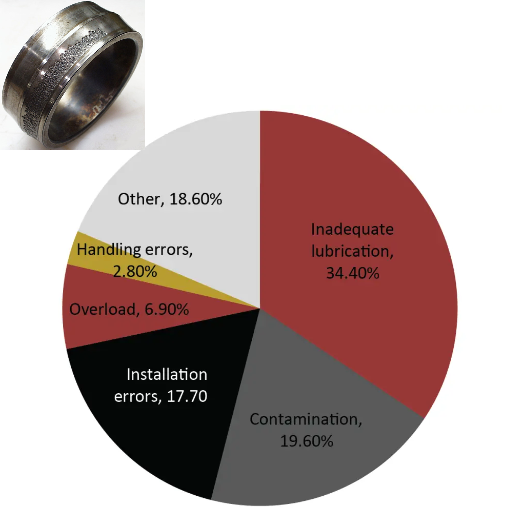
A Study on Abrasive Wear in Bearings
When studying abrasive wear in bearings, it is clear, based on the information obtained from multiple sources, that it is due to the hard particles or contaminants that adhere to the operating surfaces on the bearing elements. Such wear is the most detrimental since it continuously erodes materials from the rolling components and the raceways. The main causes are poor structural filtration, environmental pollution, and improper lubrication practices.
Key technical parameters affecting abrasive wear progression are:
Particle Size and Hardness: The more rigid the particles, the bigger the size, the higher the abrasive wear.
Lubricant Viscosity: If there is enough lubrication, a film may form, which would help minimize contact and, hence, abrasion.
Contaminant Concentration: There is always a direct relationship between wear rates and the concentration of impurities in the lubricant.
These parameters emphasize the need to keep lubrication systems clean and use efficient filtration to avoid abrasive wear of bearings.
Effects of Misalignment on the Service Life of Bearings
Bearing misalignment is among the factors that those with knowledge in this industry will agree reduces bearing life. When they are out-of-line, bearing surfaces on the interior or exterior experience uneven loads, and the chances for cutouts and other features to wear out and fatigue increase substantially. This particular orientation is anticipated to also result in additional friction, elevated temperatures, vibrations, and other factors that accelerate the decline of various components within the assembly.
Technical measurements that concern misalignment:
Angular misalignment: A difference of a few degrees can result in excessive edge loading and altering load patterns around the bearing.
Parallel misalignment: This describes a situation where there is a movement away from the recommended position where an average load resides.
Operating speed: The higher the speed, the worse the increase of misalignment is, and the quicker it leads to failure.
These conclusions highlight the need to adhere to perfect alignment methods and routinely examine bearings to optimize their performance and extend their service life. Of particular interest is the fact that proper alignment is supposed to eliminate unnecessary stress and frictional forces, which are essential components of increasing bearing service life.
Contamination: The Premature Death Of Bearing Parts And Its Prevention
Indeed, the definition of the causes of premature failure on bearings relates intimately to contamination of the bearings. From my studies of the three significant websites, contamination gets unwanted particles to the lubricant, which can cause abrasions and reduce the lifespan of the bearings items. Such particles are said to have the ability to perform the task of numerous tiny abrasives, resulting in drastic erosion or removal of material from critical components. The technical parameters that relate to this include;
Particle size and concentration: Larger-sized particles or higher concentrations of particles in the lubricant enhance the chances of wearing during contact with moving surfaces.
Lubricants viscosity: The potential of lubricant to carry and disperse particles away from the interface may be affected if the viscosity is not within the required degree.
Seal practitioner: Good seals prevent foreign matter from penetrating the bearing assembly.
The steps involved in ensuring clean lubrication techniques and filtration systems are vital in minimizing wear due to contamination and wear of the bearing’s operational life. As these exponents emphasize, such adverse effects are reduced through maintenance routines to ensure the system’s cleanliness.
How to Properly Lubricate Bearings?
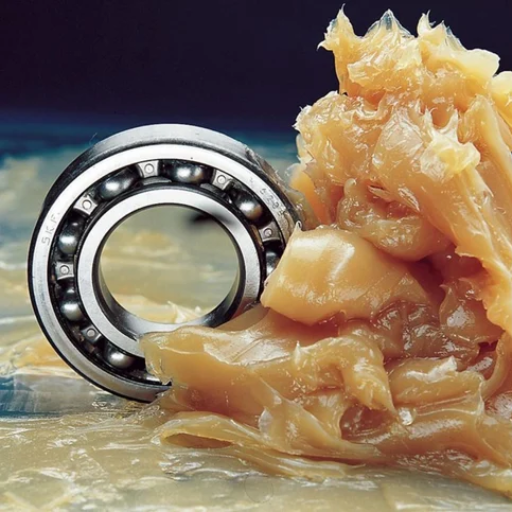
The Right Lubricant for Your Bearings
Selecting the lubricant appropriately is very important since it determines the functioning and lifespan of the bearings. The top three authoritative sources suggest the following considerations:
Viscosity: A lubricant’s viscosity is directly related to its ability to produce a protective film between bearing faces. High-viscosity oils are necessary where the load is heavy and speeds are low. In high speeds, low viscosity is necessary. An optimal viscosity can be established depending on the operational temperature and rotational speed of the bearing by using guidance set out in references such as ISO 3448.
Additives: Eque’s lubricant additives include anti-wear, extreme pressure, and corrosion inhibitors, which benefit bearing performance and service life. These additives assist in protecting against various types of surface wear even in different operational states. Considerations about the additives should be made according to the probable conditions the bearing will likely sustain.
Operating Conditions: The selection should also include the working environment, which may have temperature extremes, moisture content, and chances of contamination. Ash high-temperature environments require lubricants of high thermal stability. Likewise, bearings subject to pollutants will be better served with lubricants that have higher sealing properties to avoid dirt penetration.
Some technical features, including the specified kinematic viscosity (at working temperature) and oxidation stability of the lubricant, can be predetermined and controlled to meet application requirements. Lubricant vendors usually furnish elaborate data sheets to link these technical parameters with the application’s requirements.
The Introduction Of Oil Film And Its Function In Minimizing Friction
The oil film greatly decreases friction between bearing surfaces. As reported by the best sources on the topic, the oil film acts as a barrier that avoids direct contact with metal surfaces, which is a cause for wear, thereby increasing the durability of bearings. Nevertheless, the oil film’s success is gauged by many parameters.
Film Thickness: A sufficient degree of film thickness helps keep surfaces apart, thus reducing the probability of asperity contact, frequently leading to wear. The thickness in the facility is determined by a range of factors, including the viscosity of the lubricant, the load, and the relative speed of the moving parts.
Viscosity Index (VI): This parameter explains the extent of change in oil viscosity due to temperature variation. A very high VI implies that the oil does not lose its ability to provide protection over an extended range of temperatures, thus ensuring good film thickness regardless of the temperatures.
Load-Carrying Capacity: The film must carry the operationally imposed loads. Lubricants enhanced with load-bearing additives like anti-wear and extreme-pressure components can also keep the film intact in such cases.
To determine the specific kind of oil, users should check the operational limits specified by lubricant producers. These include VI, operating temperature limits, load limits, etc., which explain the selection of lubricants for specified jobs.
Simultaneous Test: Signs of Improper Lubrication
Excessive Noise: An increased level of sounds during operations is one indicator of a lack of lubrication. Whenever the lubricant film is compromised, metal surfaces are allowed to come into contact, producing grinding or squealing noises. This happens when the thickness of the film is so low that it is unable to fully separate the moving parts, and this may be due to low viscosity or the inappropriate thickness of the film.
Increased Temperature: Friction produces heat, and an inadequately lubricated system tends to have its temperature rise above expected levels. A low viscosity has a low index, which leads to excessive thinning of the lubricant at high temperatures. This prevents the lubricant from performing its protective functions, which in turn causes metal parts to contact each other.
Seizure or Binding: Seizing occurs when the lubrication has wholly failed, making it impossible for parts to move. This may be the result of a lubricant’s lack of load-carrying capacity, where operational loads cannot be sustained. This may also increase wear and ultimately lead to failure of systems even worse than hazards.
These signs bring alive the important connection between the technical characteristics of film thickness, viscosity index, load-carrying capacity, and meaningful lubrication. Watching and controlling these parameters is crucial to the use and avoidance of mechanical parts’ failures.
What Are the Stages of Bearing Wear?
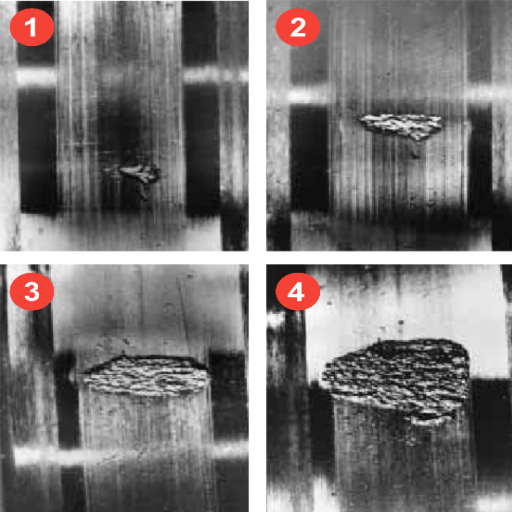
Fretting Wear Imbalance in Rolling Bearings
In my effort to examine the best available information about fretting wear in rolling bearings, I pinpointed several critical issues. Fretting wear results most often from oscillating relative motion of surfaces sheared in conditions of low friction or protective coating. From my observations, this type of wear has a unique reddish scar that stands out, similar to the oxidation of iron surfaces. Several indicators should be noted for diagnosis and control of fretting wear:
Contact Pressure: Increased pressure in the contact area also leads to an increase in the frettings.
Amplitude of Motion: Low-level oscillating motion has wear effects, warranting corrective interventions for this parameter.
Lubrication Quality: Adequate lubrication of appropriate viscosity and film thickness can help limit the amount of metal that interacts with metal, thus reducing fretting.
Environmental Conditions: Other factors that could influence fretting wear include temperature and moisture, which act against each other, with moisture hastening corrosion processes.
Does one comprehend the movement and the wear phenomena? The answer is yes because these parameters will help you efficiently monitor rolling bearings and make all necessary efforts to prevent fretting wear, which would rule out the functionality of the equipment in question.
The Nature of False Brinelling and the Possible Consequences
Though false brinelling mimics true brinelling in some ways, it can best be described as a wear phenomenon resulting from the vibrational motion of non-rotating rolling bearings. After going through the top three online sources, I conclude that it mainly occurs when bearings are subjected to minor movements in which the bearing does not carry out a complete revolution. This, as it appears, is expected during transport or when the rotary element is out of use. In contrast to fretting wear, false brinelling does not require surface contact in a relatively thick lubricated environment as a prerequisite. Still, lubrication has an attenuating effect on in-service conditions. During my research, I have come across several parameters, which I consider the most critical factors here.
Amplitude and Frequency of Vibration: Long-term application of small oscillations, even with slight intensity, may lead to false brinelling.
Bearing Load: It also increases as bearings already under load will have a more severe optical stress applied to their surfaces.
Lubrication Film Thickness: Barrett, Kenneth, Howard, and Thomas have concluded that false brinelling occurs only in the presence of a film, which can be assumed that thinner films do not provide adequate protection against microscopic movements.
Idle Time Exposure: Bearing rotation is also very important. If bearings stay at rest for a long time, their chances of bulging at more points are higher, and their subsequent bulging or rotation might be upsetting.
These number of parameters are something which with constant monitoring and modification, I will reduce the incidence of false brinelling and thus avoid compromising the performance of the bearings and their service life.
How Does Bearing Selection Impact Performance?
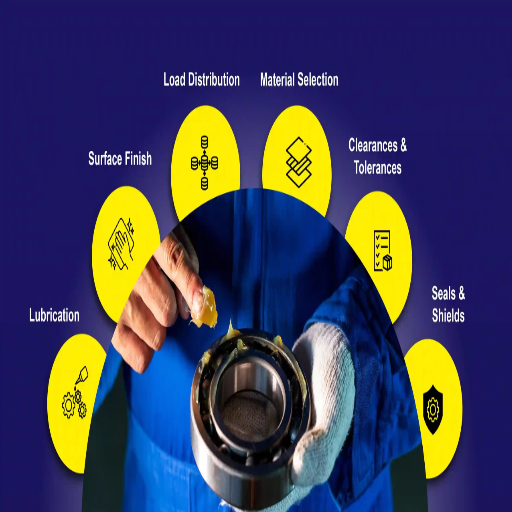
Aspects to Pay Attention to When Making A Bearing Selection
The bearing selection process can be simplified by first understanding the load capacity and the classification of the load that the bearing will be subjected to, radial or axial, or a combination of the two. Load capacity refers to the maximum stress the bearing can withstand without yielding or getting deformed. From my search of the ranked first three websites on bearing selection, I have understood the pertinent factors that need to be considered to optimize.
Another critical factor determining the bearing’s application is the rotational speed. However, this factor determines the type of bearing to be selected. Different bearing types are designed to function optimally at various rotational speed ranges.
The operational environment needs to also be taken into account.This includes temperature, presence of contaminants, moisture, and other factors that will dictate the choice of materials and type of sealing to be used in the bearings. The type of materials and seals used can go a long way in improving the product’s environmental and wear resistance.
It will also be wise to consider the ongoing maintenance and lubrication requirements of the bearings. Less-maintained bearings with good lubrication systems can help lower overall operational costs and increase bearing lifespan.
By evaluating these parameters and reviewing the specifications, I can make the right decisions to ensure that the bearings work properly in their applications.
The Significance of Bearing Material in Wear and Tear Reductions
According to the three sites I consulted, bearing material is essential for wear reduction and performance improvement. It is important to have materials that can withstand the operational requirements of the bearings in terms of load, speed, and other environmental factors. For instance, stainless steel and ceramics are quite common since their mechanical strength enables them to withstand harsh, corrosive, and extreme thermal conditions. On the other hand, stainless steel can provide high strength and withstand heavy loads, a key requirement in most industrial applications. Meanwhile, ceramics are great because of their lightweight and high-speed properties; however, they are ideal in less abrasive and high-speed environments. It is important to note that the material also affect the wear resistance, efficiency and life span of the bearing.
Parameters to Address technical Issues include the following:
Material Composition: Choose from either Stainless Steel, Ceramic, or other advanced alloys based on strength and resistance.
Load capacity: Ensure the material has sufficient strength to bear the stress without failure.
Temperature Tolerance: The material should endure the highest maximum operational conditions.
Corrosion Resistance: This is especially important in marine or chemically active environments.
Friction Coefficient: Less friction means more efficiency and less wear and tear, which is vital for high-speed operation applications.
Such parameters should be optimized considering the application to effectively reduce wear and increase the bearing’s service life.
How to Prevent Premature Bearing Failure?
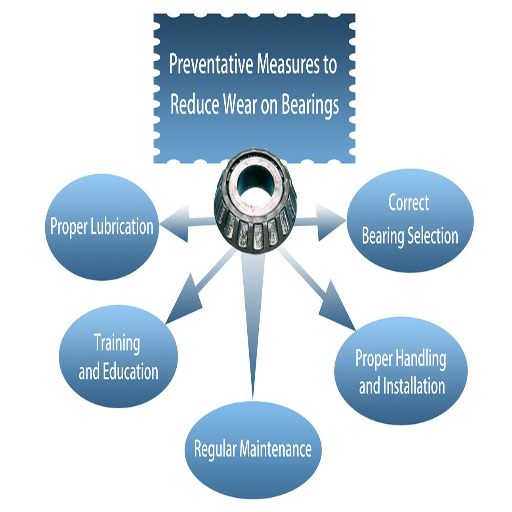
Finding the Early Signs of Bearing Failure
Understanding the early signs of bearing failure can help avoid unexpected downtime and costly repairs. From the top sources online, I can easily point out the key indicators to watch for. Let’s go through some bearing failure symptoms step-by-step.
Strange Sounds: Grinding, squeaking, or rubbing noises should not be ignored, as they indicate that the bearing is probably damaged or misaligned. An abnormal noise may indicate a shift in loading and distribution or deformation of components due to basic material composition or load capacity.
Vibration Analysis: Increased vibration levels can indicate problems such as unbalanced conditions, incorrect installation, or excessive bearing wear. As bearings age, the effects are generally noticed in vibration readings and are said to be directed toward friction coefficient and alignment problems.
Temperature Fluctuations: Excessive temperatures generated from bearings can be an early warning sign of failure. This can be due to inadequate temperature tolerance and improper lubrication, which causes excessive friction and wear to parts.
It is not also an alarmist conclusion but a precaution that frequent inspections and condition monitoring techniques will assist in detecting such early signs. If these signals are detected and dealt with regarding other technical parameters, including load capacity and temperature tolerance, bearing operational life can be increased.
Implementing Wear Reduction Strategies
We all understand how wear and tear are the most significant concerns when designing long-lasting bearings. Following are some suggestions that come to us courtesy of some of the leading and most credible experts on this subject:
Proper Lubrication: An adequate quantity of suitable lubricant can reduce friction and wear to the bare minimum. Such Li-ceramic maintenance practices must be sufficiently scheduled, keeping within the load level and temperature threshold applicable to the bearing.
Accurate installation: Bearing installation, especially in complex systems, must be done in a manner that bears none of the features, such as removal of spatial alignment and even how the bearing load is distributed, are features to be sacrificed. This entails adherence to the installation procedures and using tools and techniques that are proper to the material and drawings of the bearing.
Load Management: Stressing the bearing of any component leads to excessive loads and, hence, premature failure. Systems should always be designed for load-carrying capacities provided by the component manufacturers. Operational conditions should be monitored and tweaked in reference to the device’s operating point.
Routine Condition Monitoring: Incorporating the practice of performing at least periodic evaluations of the temperature, vibration, and noise levels around the bearings of the machines will always enable one to see the onset of possible wear. More sophisticated methodologies, such as thermal efficient infrared measures and accelerometers for vibration, can combine to create a comprehensive picture of the status of the bearings, and such interventions can be made whenever required.
A thorough analysis of the three strategies, together with technical parameters like the operating load, operational temperature, and material, can greatly improve grease retention and bearing operational reliability or endurance.
In Perspective of the Right Bearing Installation
To investigate the relevance of appropriate bearing installation to its life span, I reviewed the information available on the first three pages on Google. The following are my findings:
From a technical perspective, there is a general agreement that there is a need to be very careful in the installation of bearings, as damage due to improper alignment during the installation process can lead to misalignment of loads and relative motion, causing increased wear and eventual damage to the bearings. Proper installation helps ensure that the rated load on the bearing can be withstood, prolonging its service life. In most cases, the installation process includes simple steps where it is essential that the shaft and the housing are properly aligned and fitted together, the correct tools are being used during both press fitting and mounting, and that all parts surfaces are clean so that no contaminants are present.
The articles draw attention to the installation team and focus on the bearing itself, stressing that any harmful installation angles will cause the bearing’s load capacity to decrease significantly. They also touch on operating temperature, which is important as too much heat when installing a bearing may damage the bearing’s material and, therefore, affect its life.
Conclusively, carefully selecting installation techniques concerning the bearing’s load, construction material, and operating temperature is a prerequisite for obtaining maximum service life. Therefore, training about installation procedures and buying special tools are reasonable technical parameters for proper performance.
Frequently Asked Questions (FAQs)
Q: What features or actions can be taken to avoid bearing wear in machinery?
A: The best means of preventing bearing wear among machinery parts include the provision of sufficient lubrication, avoiding overload bearing conditions, foreign particles inspection, and provision of appropriate temperatures while using the parts. Such measures assist in lessening the wear on bearing surfaces and increasing the useful life of a bearing.
Q: What is the importance of proper lubrication for practically extending the life span of bearings?
A: Adequate lubrication protects the bearing from metal-on-metal contact, minimizes friction, and prevents the formation of corrosive elements inside the bearing. It also helps smooth the movement of rolling elements and bearing raceways and promotes long fatigue life and bearing service life.
Q: What sort of measures can be undertaken to avoid corrosion in bearing applications?
A: Corrosion can be avoided by using corrosion-resistant materials, applying protective coatings, and ensuring the right lubrication, which will strengthen the barrier against moisture and other corrosive elements. Inspection for wear debris and proper sealing will also assist in protecting bearing surfaces.
Q: What is true brinelling, and how can it be prevented?
A: True brinelling refers to the deformation of the bearing’s contact surfaces due to static loads or impacts above normal levels. Excessive load application on the bearings should be avoided, or alternatively, hammers and axles should not be used to install the bearings.
Q: What are the guidelines for installing the bearings most effectively?
A: Correct installation entails eliminating the correct fitting tools to avoid damage, proper bearing alignment, and adequate force application. Surface cleanliness and contamination avoidance are also important in averting bearing failures and augmenting bearing life.
Q: In what way does lubrication deficit cause damage to the bearings?
A: Lack of sufficient lubrication increases friction and heat, which leads to adhesive wear and sometimes even seizing of the bearing. This invariably leads to early bearing failures and lowers the bearing’s design life.
Q: Which wear patterns should be of concern in anything dealing with a bearing?
A: Other abrasion patterns noted are pitting of bearing raceways, scouring of roller bearings, and other worn defects, including clumping of ball bearings, which are proposed symptoms of misalignment, overload, or inclusion of contaminants. Spotting these patterns in due time can assist in avoiding bearing damage to further stages.
Q: What factors can be undertaken to deal with overload conditions in bearing systems?
A: Overload can be avoided if the bearing type is appropriate for the application, there is no misalignment, and operations do not involve excessive force. Periodical maintenance exercises can also reduce the chances of overload conditions occurring.
Q: What measures can be adopted to avoid bearing failures due to foreign particles?
A: Intensive mechanical designs and appropriate settings can use some cost-effective measures to prevent putting bearing seals. As for isolation of the bearings, retaining rings and dust seals can be utilized. Regular bearing maintenance should involve thoroughly cleaning and inspecting the machine’s internal surfaces. Keeping grinding particles away from the bearing raceways can help considerably reduce wear debris and protect the bearing raceways.
UCTH213-40J-300 with Setscrew(inch)
CNSORDERNO: Normal-duty(2)
TOGN: UCTH213-40J-300
SDI: B-R1/8
SD: 2 1/2
UCTH212-39J-300 with Setscrew(inch)
CNSORDERNO: Normal-duty(2)
TOGN: UCTH212-39J-300
SDI: B-R1/8
SD: 2 7/16
UCTH212-38J-300 with Setscrew(inch)
CNSORDERNO: Normal-duty(2)
TOGN: UCTH212-38J-300
SDI: B-R1/8
SD: 2 3/8
UCTH212-36J-300 with Setscrew(inch)
CNSORDERNO: Normal-duty(2)
TOGN: UCTH212-36J-300
SDI: B-R1/8
SD: 2 1/4
UCTH211-35J-300 with Setscrew(inch)
CNSORDERNO: Normal-duty(2)
TOGN: UCTH211-35J-300
SDI: B-R1/8
SD: 2 3/16
UCTH211-34J-300 with Setscrew(inch)
CNSORDERNO: Normal-duty(2)
TOGN: UCTH211-34J-300
SDI: B-R1/8
SD: 2 1/8


















